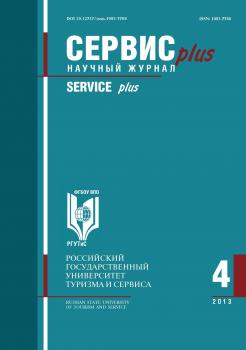The article presents a demographic analysis of a peasant family in a village near Moscow hndin the period of the War of 1812. The subject hardly has been studied in the historical literature. Source base of this study were the documents extracted from the funds of the Central Historical Archive in Moscow. Statistical processing was performed for massive public documents and records of the church: revision lists, confessional and metric sheets (books). In them there is the nominal composition of residents of the yard, their age, family relationship. The object of the study was medium and large landed estates of Moscow and Zvenigorod district - the village of Fili and Mazilovo A.I. and D.I. Naryshkin and Selco Zakharovo of H.I. Kozlova. All three of the villages for nearly two months were occupied by French troops. On the basis of a systematic scientific approach addressed are issues such as the population of the yard, the composition and structure of the family, its human resources and typology, the moral values of the peasants in the extreme conditions of life. These issues are analyzed by comparing the key demographic indicators as the pre-war and post-war periods. These data indicate a deep demographic crisis peasant family near Moscow after the war of 1812, sharply increased mortality, reduced working capacity, the number of widows, widowers, orphans, deserted courtyards. According to the documents, only the preservation of spiritual and moral traditions, mutual aid, charity-related debt, aid from the rural world, the state and landowners have allowed farmers to survive and keep many families. But restoring the normal functioning of rural families in these settlements occurs only in the second half of the 20-s and early 30-s of 19 century. The results can be used in the formation of information base of research on Russian history and historical demography.
peasants, population, family composition, structure, typology, labor, extreme conditions.
Введение. Проблема положения семьи, как основной экономической и социальной ячейки человеческого социума, имеет особую научную и практическую значимость. Успешное разрешение острейших семейно-брачных отношений (их деформация, дефицит духовных ценностей и т. п.), возникших в современном российском обществе, неразрывно связано с изучением демографических особенностей нашего Отечества в прошлом. Рассмотрение истории нравственных традиций народов России является приоритетным научным направлением фундаментальных исследований Российской академии наук [8].
Вопросы, связанные с низкой рождаемостью и высокой смертностью, общественной значимостью семьи, ее типологией, были в центре внимания российских историков и демографов на протяжении XIX-начала XXI вв. [5]. Общие методологические и теоретические исследования семейно-брачных отношений в России нашли отражение в отечественной [1, 4, 11] и зарубежной [18, 19, 20, 22] историографии. Отметим, что в современной российской исторической науке усиливается интерес к западноевропейским методологическим подходам в области микроистории, «моральной экономики», социальной и культурной истории [2, 9, 16].
В то же время в современной российской историографии заметна явная неравномерность при рассмотрении истории семьи в социальном
1. Aleksandrov V.A. Tipologiia russkoi krest´ianskoi sem´i v epokhu feodalizma [Typology of Russian peasant family in the era of feudalism]// Istoriia SSSR. 1981. № 3.
2. Anri L., Blium A. Metodika analiza v istoricheskoi demografii [The method of analysis in historical demography]. Per. sfrants. M., 1997.
3. Boldina E.G. Sostoianie Zvenigorodskogo uezda posle osvobozhdeniia ot nepriiatelia v 1812 g. [State of Zvenigorod district after the liberation from the enemy in 1812] // К 200-letiiu pobedy Rossii v Otechestvennoi voine 1812 goda. B. Viazemy - Melikhovo. 2013.
4. Mironov B.N. Sotsial´naia istoriia Rossii perioda imperil (KhVIII - nachalo KhKh v.): Genezis lichnosti, demokraticheskoi sem´i, grazhdanskogo obshchestva i pravovogo gosudarstva T. 1, 2. [Social History of Russian Empire period (XVIII - beginning of XX century.): Genesis of personality, democratic family, civil society and the rule oflaw. T. 1, 2.]. SPb.: Dm. Bulavin, 2003.
5. Prokofeva A.Iu. Rossiiskaia sem´ia KhVIII-KhIKh w: analiz istoriografii [Russian family XVIII-XIX centuries .: analysis of historiography] // Rossiiskaia istoriia. 2011. № 4.
6. Prokhorov M.F. Krest´iane-ratniki 1812 g. iz podmoskovnoi Filevsko-Kuntsevskoi votchiny Naryshkinykh [Peasant Warriors in 1812 from Moscow Filevsko-Kuntsevsky fiefdoms Naryshkins] // 1812 g.. Liudi i sobytiia velikoi epokhi. M., 2013.
7. Prokhorov M.F. Krest´ianskaia sem´ia sel´tsa Zakharovo Zvenigorodskogo uezda v Otechestvennoi voine 1812 goda [Peasant Family hamlet Zakharovo Zvenigorod district in the Patriotic War of 1812] // A.S. Pushkin v Moskve i Podmoskov´e. B. Viazemy, 2014.
8. Rossiiskaia akademiia nauk. Razdel: fundamental´nye issledovaniia. Plan fundamental´nykh issledovanii Rossiiskoi akademii nauk na period do 2025 goda [Russian Academy of Sciences. Section: basic research. Plan for Basic Research of the Russian Academy of Sciences for the period up to 2025] //ras.ru. (data obrashcheniia: 20.04.2015) [Accessed April 20, 2015].
9. Skott Dzheims S. Moral´naia ekonomika krest´ianstva. Vosstanie i vyzhivanie v Iugo-Vostochnoi Azii [Moral economy of the peasantry. The uprising and survival in South-East Asia] //Otechestvennaia istoriia. 1992. T 5.
10. Fedorov V.N. Ratniki 1812 g. izselaShevardino//Voprosyistorii. 2003. № 1 [Warriors in 1812 from the village Shevardino].
11. Shveikovskaia E.N. Russkii krest´ianin doma i mire: severnaia derevnia kontsa KhVI - nachala KhVIII v. [Russian peasant house and the world: the northern end of the village of XVI - the beginning of the eighteenth century] M.: Indrik, 2012.
12. Khok S.L. Krepostnoe pravo i sotsial´nyi kontrol´ v Rossii. Petrovskoe, selo Tambovskoi gubernii [Serfdom and social control in Russia. Petrovskoye, the village of Tambov province]. M., 1993.
13. TsIAM. F. 51. Op.8. №38. P. 63-69; №94. P. 182-189; №132. P. 1248-1310; №229. P. 89-96; F. 203. Op. 747. №826. L. 517-520; №831. L. 500-503; №877. L. 143-146; F. 2132. Op. 2. №77. F. 1-37; Ul´ianovskii A.F Niania Pushkina. M. - L.; 1940. S. 99-102.
14. FsIAM. F.16. Op.6. №236. F. 4-6; F. 383. Op.l. №189. F. 3-36; №190. F. 27-28.
15. 10. FsIAM. F. 17. Op.l. №524. F. 6; F. 389. Op.3. №64. F. 8; PSZ. 1-е izd. SPb., 1830. F. 32. №25273, 25340,25375,25671.
16. Avdeev A., Blum A., Troitskaia I. Seasonal factor in demography of Russian peasantry in the XFX-th century// European population conference. Helsinki. 2001.
17. Blum A., Froiskaia I and Avdeev A. Family, marriage and social control in Russia. Fhree villages in Moscow region// Neven M and Carpon С (eds). Family structures, demography and population. A Comparison of societies in Asia and Europe. Fiege. 2000.
18. Brower Daniel and Fazzerini Edward (eds.). Russia´s orient imperial Borderlands and peoples, 1700-1917. Bloomington: Indiana University Press,1997.
19. Dixon S. Fhe modernization of Russia, 1676-1825. Cambridge University Press, 2006.
20. Freeze G.F. Bringing Order to the Russian family marriage and divorce in Imperial Russia, 1760-1860// Fhe Journal of modern history, University of Chicago Press. 1990. Vol. 62. №4.
21. Hoch S. Serfdom and social control in Russia: Petrovskoe, a village in Fambov. Chicago. 1986.
22. Moon D. Fhe Russian Peasants, 1600-1930. Fhe World the Peasants Made. Fongman. Fondon and New York. 1999.

















